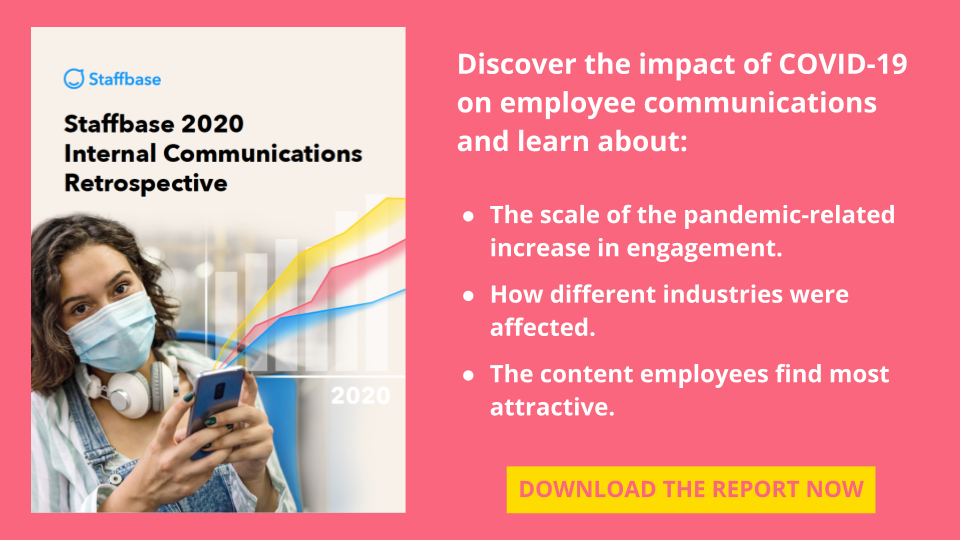Top 5 Intranet Trends for Today’s Digital Workplace
In a digital workplace changed by Covid-19, more and more organizations are recognizing the power of the employee experience to engage, connect, and communicate with a workforce that’s forever changed.

With Microsoft’s announcement of Viva, their employee experience platform, the employee experience (EX) concept is now fully impacting the way companies think about their digital workplace. That’s why the influence of EX on the requirements of modern intranet software tops our list of the top 5 intranet trends.
James Robertson, Managing Director of Australia’s Step Two, has been a leading voice on employee experience for many years. This article draws extensively on insights and slides he shared in the Staffbase webinar, 5 Intranet Trends.
Organizations worldwide have been experiencing a complex but dynamic evolution in which they’ve begun to seize a unique opportunity to shape their digital destiny. That’s a theme we’ll see repeatedly as we dive a bit deeper into the five intranet trends shaping current thinking.
1. Employee Experience is changing the digital workplace.
Customer experience (CX) drives public opinion as much as the services a company provides. Given that knowledge, organizations have made massive CX developments in the past two decades, all done with the understanding that customer service is really what wins the war for customers.
But the moment companies start talking about customer experience, the next logical question becomes, “Who delivers these services?” The answer, of course, is employees. It therefore stands to reason that we should be talking about the employee experience as being just as important as customer experience in terms of the health and the success of an organization.
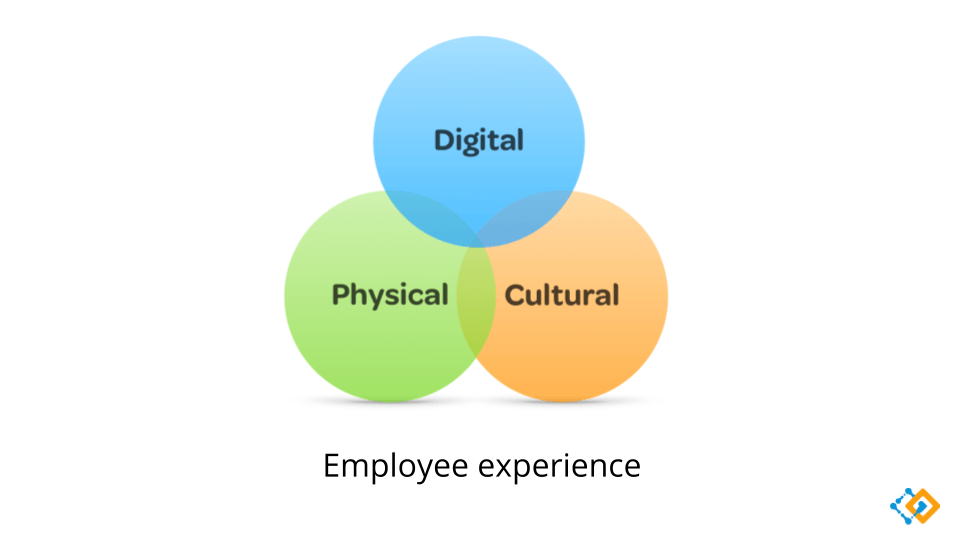 3 workplace environments make up the employee experience.
3 workplace environments make up the employee experience.
There are three elements of the employee experience. First is the physical component, which of course was utterly upended by Covid-19. Second is the digital component. And finally there’s a cultural component. Only when all three of these are brought together do we start to see a clear picture of what employee experience is and why it’s so important.
What about digital employee experience?
The definition of digital employee experience is similar to customer experience. It’s the sum total of an employee’s digital interactions within their work environment. And it’s not just about the top-down provision of services to employees in a passive, receiver mode. It’s actually about the environment in which employees work with each other and the methods they use to do so.
Digital employee experience must now be viewed through a completely different lens because of Covid-19, when suddenly so many workers moved to remote work and largely remained there.
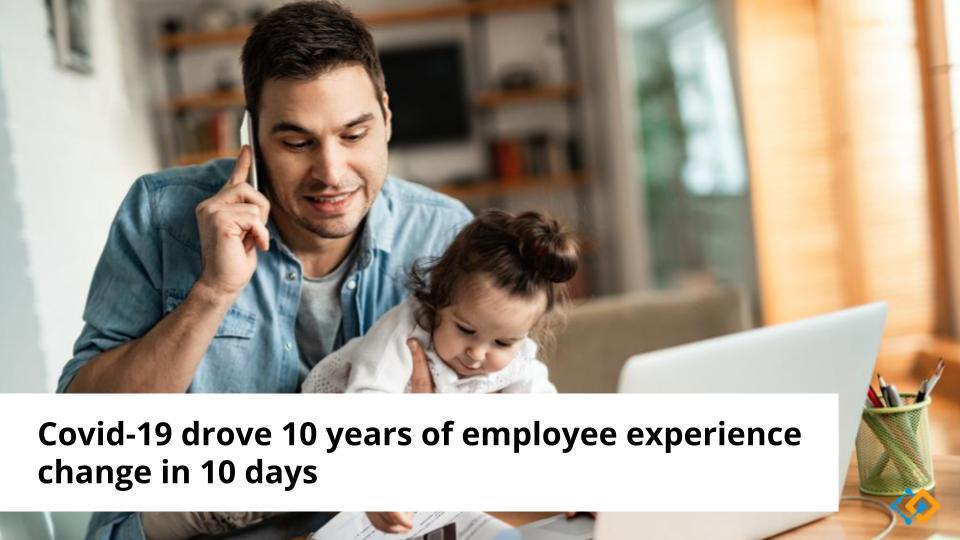
Though the pandemic was incredibly challenging, one positive outcome was that ten years of EX change happened in about as many days, jolting the digital workplace forward. What it has also proven is that you can’t deliver a better customer experience than your employee experience.
Here are 3 ways companies can start thinking about their digital employee experience:
Create an overall vision. What do we want a day or a week in the life to look like digitally in our organizations going forward?
Set guiding principles. What shapes our decisions about the tools and services our company delivers and how they fit together?
Take some concrete actions. What are the first steps we can take to either plug the gaps or join the pieces or push the overall DEX picture forward?
What about the crucial middle part of the employee experience?
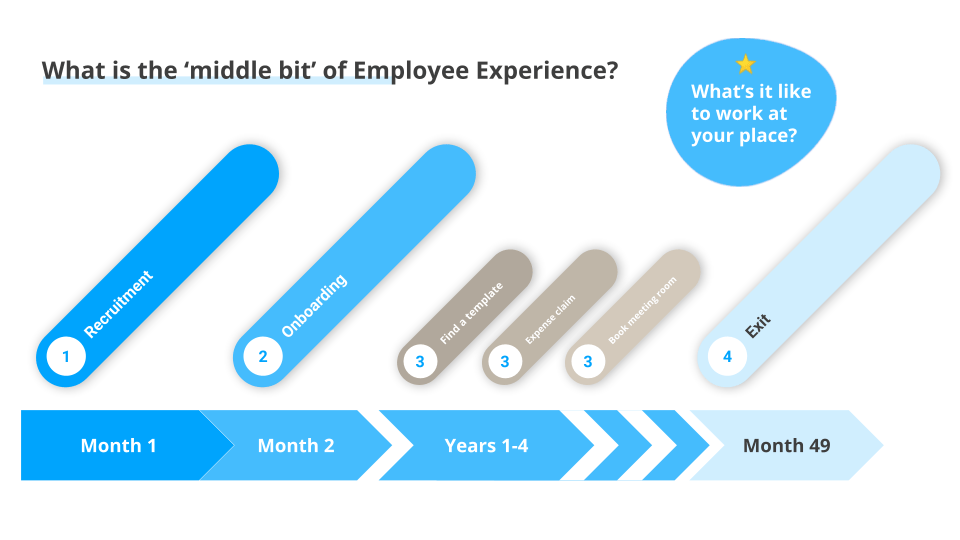 Employee experience tends to focus on the beginning and end of the employee journey, but it’s the middle part where perceptions are truly formed. (This illustration is from the webinar, 5 Internal Communication Trends for 2021, with Sam Marshall of Clearbox Consulting.)
Employee experience tends to focus on the beginning and end of the employee journey, but it’s the middle part where perceptions are truly formed. (This illustration is from the webinar, 5 Internal Communication Trends for 2021, with Sam Marshall of Clearbox Consulting.)
People who’ve tried to sell an employee experience project inside their organization have likely faced pushback. EX initiatives have tended to focus narrowly on the obvious areas of recruitment and onboarding. These are indeed important phases: people are generally either disappointed or excited by organizations within their crucial first couple of days. Offboarding is an important step, too. Employees leave for other jobs and their offboarding defines how they talk about their experiences with their previous organization.
But what about the broad middle bit of employee experience? What are the real moments that matter for employees? Organizations need to be sure that they understand exactly what these are for each individual employee. They can of course be tied to factors like engagement, recognition, or personal development. But they have everything to do with the day-to-day working lives of employees when they’re actually getting work done.
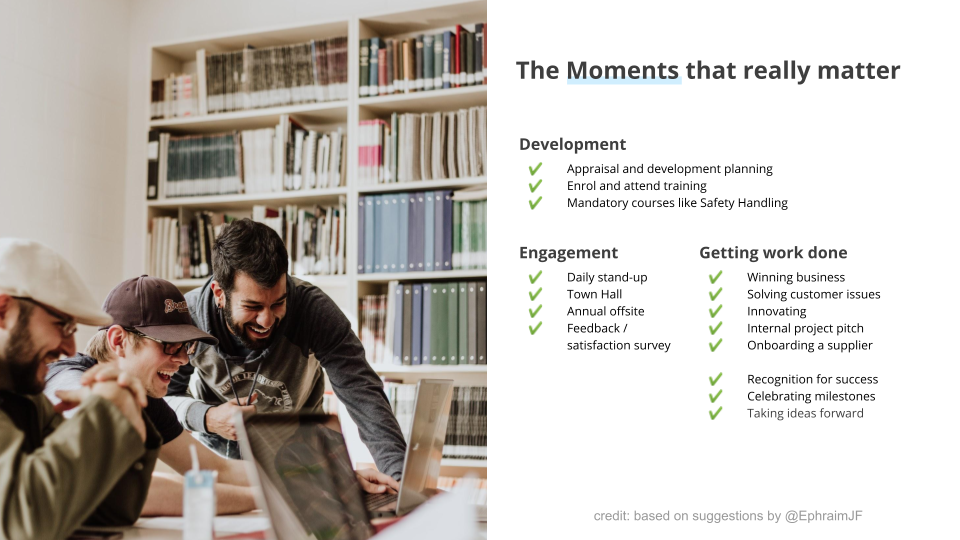 Intranet trends need to focus on the workplace moments that matter happening every day.
Intranet trends need to focus on the workplace moments that matter happening every day.
Virtual events in the age of Covid-19
When you think about factors that tie together the three elements of employee experience, there’s no greater example than an employee event. During the pandemic, companies had to learn how they could hold events in a way that’s engaging and close to real life. One of the more interesting intranet trends is how companies have found ways to move employee events online.
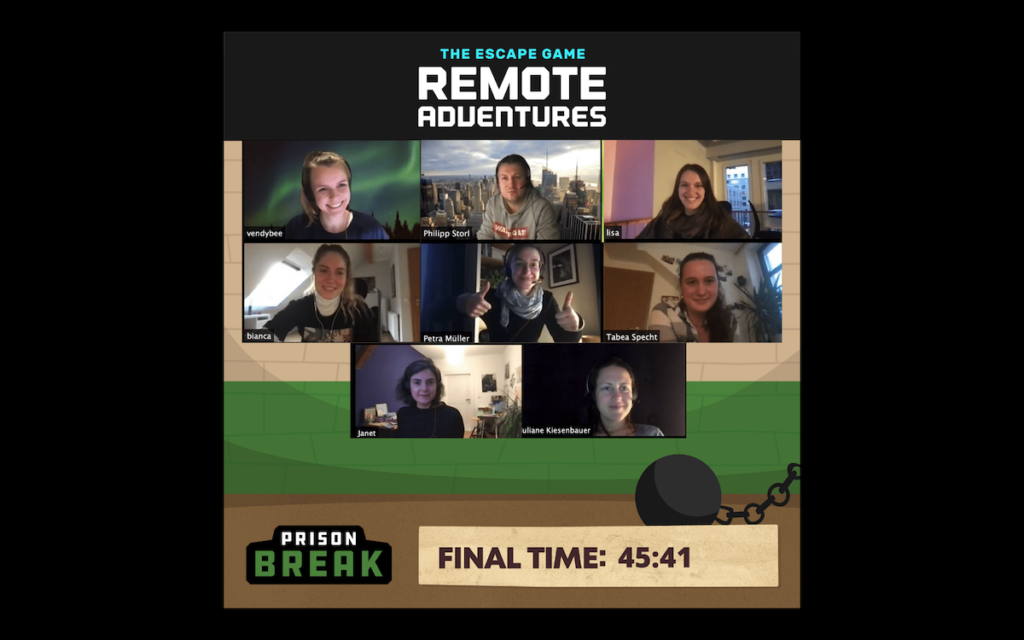 Virtual employee events can be every bit as engaging as those happening in real life.
Virtual employee events can be every bit as engaging as those happening in real life.
An unexpected outcome is that virtual events have shown that they have certain advantages over those happening IRL.
Step Two worked with a small government agency right through the middle of the Covid-19 crisis. Their annual town hall meeting had always been very formal and managed. But of course, in 2020 they had to move it online for the first time. Guess what? They loved it! It was still managed carefully but it was by far the most engaging event they’d ever held. Why? Because the CEO was sitting at home. And because she was in that home environment, she spoke like a real person, with a degree of informality. Now they’re saying, ‘We’re not going back to the old way.’ And I hope they don’t because maybe this supposedly disconnected digital experience is better than the connected, in-person one.”
James Robertson
How can companies bring employees together in an era of remote work?
So, while employee experience is a concept that’s been around for a while now, it’s getting a real push from the repercussions of the Covid-19 crisis. Middle and top management are rightly concerned about having their employees at home and in their own bubble. They want to know how they can bring their people together. This is a question we’re sure to see as new requirements for flexible work mean that remote work is here to stay.
The good news is that it’s now much easier to talk about EX with senior leaders and the C-suite than it has been in the past. The light has finally been turned on by the repercussions of the pandemic, which made certain shortcomings glaringly obvious.
HR in particular have been been very quietly talking about employee experience for 5+ years. Now, they’ve been given a set of concrete steps that they can take to improve the employee experience – especially the important digital aspect of it.
2. Frontline Employees are changing basic intranet requirements.
Frontline employees have been doing deskless work forever. But a lot of employees who’ve traditionally been sitting at desks are currently remote, too. Now that everyone has an idea what it’s like to be working outside of the office, it makes sense that there’s a brighter spotlight on the distributed workplace.
On the other hand, there are the employees who can’t work from home. These essential workers are the backbone of many organizations and they’re the ones who carried those businesses through the pandemic.
 Current intranet trends are shining a spotlight on our essential workers.
Current intranet trends are shining a spotlight on our essential workers.
15 years ago, Mr. Robertson wrote an article discussing the paradox of remote workers. These are the people who aren’t in the office; they’re not sitting in meetings; they’re not chatting around the watercooler. These employees are the most dependent on digital channels and internal communications; yet paradoxically, they’re the hardest to reach.
Not only are frontline workers physically separate, but they face digital infrastructure challenges that make it harder for them to be effectively reached, particularly if they’re scattered widely. There are time zone differences and the very real problem of “out of sight, out of mind.”
It’s too easy to forget these employees, but they’re the ones you need to remember most – that’s the paradox.
Frontline workers are most likely to be dealing with your customers, and therefore they deserve the most attention.
It took a pandemic for organizations to finally realize that their frontline staff – or blue-collar workers – are in fact crucial to their success. Obviously, these people include nurses and doctors in hospitals, but also employees in fields like public transport. Staff like the people in the warehouse who make sure we don’t run out of toilet paper. Suddenly, these roles have been shown to be pivotal.
Let’s tell the story of one of these frontline workers.
Anna is from an organization in Australia that provides home-based care to children and adults with disabilities. Anna loves her job, and she wouldn’t want to do anything else. But it’s not easy, either in the services she provides or in her ability to fulfill her activities as an employee. If we look at Anna’s employee persona, we see that it’s inspiring in terms of what she does. But in terms of making it easy for Anna to do her work, she faces obstacles.
 Giving frontline workers more unified access to the tools and services they need to do their work is part of what makes EX such a powerful concept.
Giving frontline workers more unified access to the tools and services they need to do their work is part of what makes EX such a powerful concept.
She has email on her device, but she doesn’t have access to the intranet and therefore lacks access to corporate internal comms. Perhaps she has access to patient records in her system, but all of the other supporting information around company policies and procedures are printed in binders that she keeps in the trunk of her car. Even simple things like changing her schedule or applying for vacation time involves going to a physical location and filling out bits of paper.
We can see how fragmented these practices are, and how much they negatively impact her ability to deliver the services that we genuinely care about. And it gets more challenging the deeper you dive into her day-to-day work.
We need to do better for Anna and workers like her. What really makes EX a powerful concept is that it enables organizations to tell stories and create empathy for the employees who truly deserve it. Companies haven’t done enough to empathize with their frontline staff. But because the technology is now so much better, the opportunity exists to really take things forward and make a difference.
Putting your frontline workers in the spotlight depends on doing two things:
Generating a sense of empathy based on real people.
Building understanding that goes deeper than a set of assumptions.
When you’re building an intranet, you’re likely to have a lot of people at the decision-making table – probably all desk workers. Often, they forget to talk about remote employees in any way that acknowledges their unique needs. They talk in assumptions; they talk about them, not with them. But once you invite a regular employee to share their experience, these meetings get way more interesting. People make an effort to understand.
That’s why creating personas based on real employees will help companies get past the assumptions they make about their needs. There is now no question that frontline staff needs and deserves better access to digital tools and services.
There’s finally greater interest from the organizational side to share better stories to drive better engagement. When you talk about intranet trends and business cases that support the building of a modern intranet, there are none more powerful.
Companies can find and share purpose through digital employee communication.
Let’s look at one great example of how the UK’s Sunbelt Rentals used digital communication to share a powerful message among their employees:
Sunbelt Rentals built Covid-19 testing sites throughout the UK, and they were able to do so very quickly by bringing together different businesses under one roof. For a testing site you need chairs, you need tents, you need traffic signs, etc. They were able to deliver all of these items. During the first lockdown, the company had an internal discussion surrounding the question, Are we an essential business? Should we be allowed to work? A lot of Sunbelt employees wanted to know, How are we essential? We’re just renting stuff.
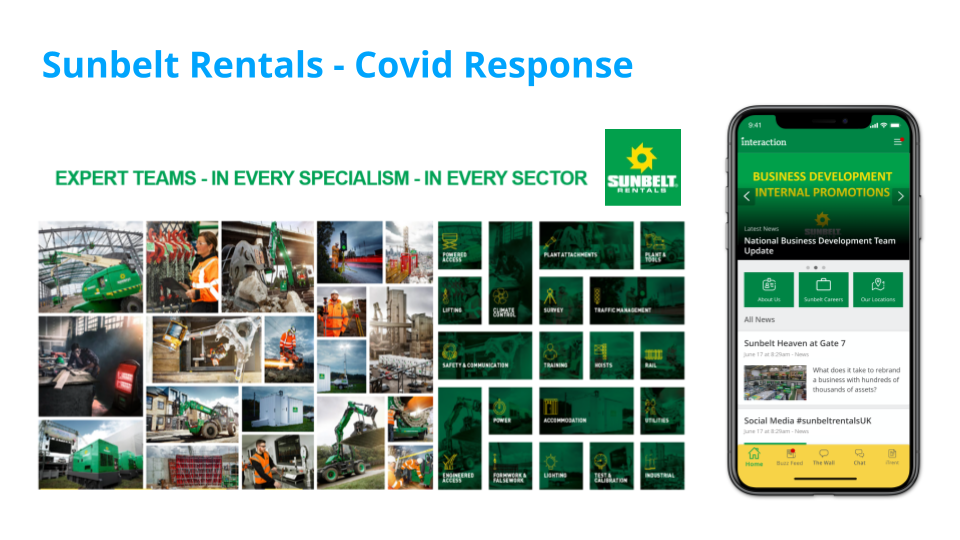 Digital communication tools helped Sunbelt Rentals spread a sense of pride and purpose amongst their frontline workers.
Digital communication tools helped Sunbelt Rentals spread a sense of pride and purpose amongst their frontline workers.
The response was, Look, we’re building the core infrastructure for Covid-19 testing in the UK. Of course we’re essential! And with their employee app, the company was able to spread this message to all of their people. The result was a sense of very real pride in the company’s work.
That’s just one example of what digital tools supporting communication can do, especially in a time of crisis.
We’ve said it before and we’ll say it again: communication is the heart of employee experience. If you think about this kind of moment when an employee realizes and maybe even tells their family, “Hey, my company is playing an important role in the battle against Covid-19,” that’s clearly a moment that matters.
Effective communication creates moments that matter that employees can share and feel good about.
3. Mobile intranets and employee communication applications have converging requirements.
Organizations need a solid business case for the intranet. Luckily, the closer you get to the frontline, the easier it becomes to demonstrate business value.
Almost certainly your organization already measures customer satisfaction. But the closer companies get to using their intranet and other digital tools to measure frontline employee metrics like satisfaction and engagement, the stronger the business case will inherently be.
Supporting frontline staff demonstrates business value.
The move of traditionally desk-bound employees to remote work necessitated by Covid-19, and the emergence of frontline workers as essential to organizational success have made it clear. Frontline employees can no longer be treated like second-class citizens, and they don’t need to be. Technology is no longer a barrier.
The technological landscape is changing. The market for employee apps-or what we’re now calling the Employee Communications Applications or ECA market-is beginning to merge with the market for intranet packaged solutions. ECAs are tools that at their core are mobile-first platforms. With their rise in popularity, many vendors have started changing the way they talk about intranet package solutions. Today, in one of the more interesting intranet trends, we’re beginning to see vendors in both markets converging into one.
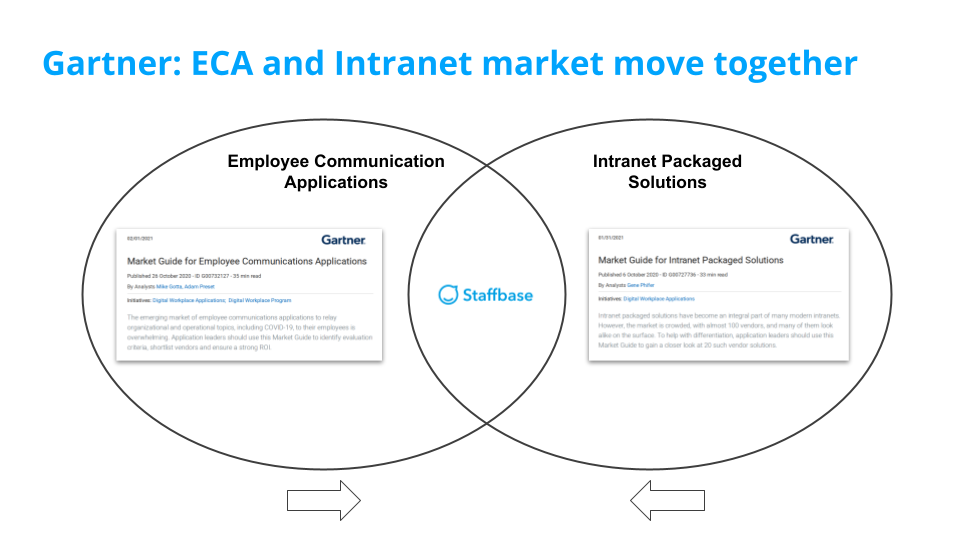 One of the more interesting intranet trends is the convergence of the ECA and intranet markets.
One of the more interesting intranet trends is the convergence of the ECA and intranet markets.
Firms like Gartner are recognizing that mobile ECAs are moving toward intranets and intranets are moving toward mobile. In two to three years, we’re likely to see the two categories merge. If you have an organization like DHL, for example, that’s spread worldwide and has a lot of non-desk employees, the intranet might make more sense coming from the ECA side of the picture. And as the two worlds of mobility and desktop merge, the decision won’t have to be either/or.
4. 2021 provides a great opportunity for establishing truly modern communication practices

Let’s start by stating the obvious: email isn’t dead. The vast majority of all internal communications in almost every organization is still done by email. No one loves it, but it’s got a real lock on how people work.
The same goes for corporate newsletters. You wouldn’t buy a newspaper with three-month-old news, yet many organizations still publish a quarterly newsletter or magazine. The one with the introduction from the CEO that was very clearly written by the internal comms team. It’s not a great medium, of course, but companies keep doing it out of a sense of momentum.
Teams that are still stuck with these methods find themselves asking, “Well, how do we measure the open rate and impact of our emails and newsletters? Let’s try an email marketing tool like MailChimp or Staffbase.” But comms teams are seeing that there’s a different direction that doesn’t revolve around emails or newsletters.
Intranet trends and requirements are changing with the new ways companies communicate.
Hopefully companies are realizing that there’s now an opportunity and a practical need to revisit the questions about how they communicate. Once they do, they’ll find that the answers are changing.
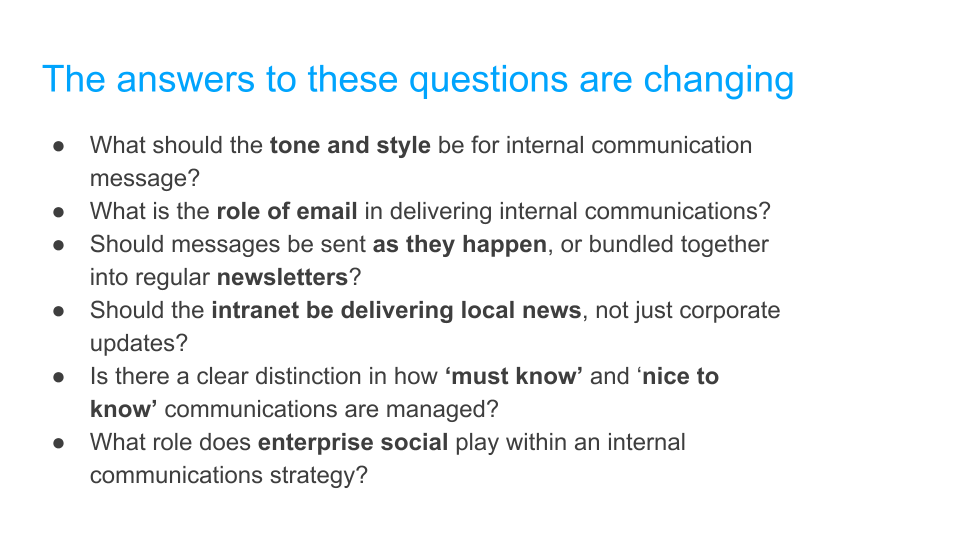
A lot of organizations thinking about delivering new intranets or internal communications channels are asking what these new platforms will do and how they’re going to work. The answer, hopefully, is a lot more and a lot better than the previous ones. There’s no point implementing these new channels if they continue to focus solely on distributing top-down corporate news.
If organizations really want to know how to target news effectively, then now is the perfect time to be exploring methods for how that can be done.
Internal comms teams have gained incredible leverage in the period of Covid-19. For many companies, employee engagement actually increased because they were finally communicating authentically, comprehensively, and practically to all employees. That momentum must be sustained.
A modern intranet needs to reach all employees.
Now that organizations are entering the new normal, they shouldn’t fall back on old comms methods. This is where IC teams can play an important role engaging senior leaders and starting to shape strategy. It’s possible now to examine the practices that were the most successful in 2020 in order to understand how great internal communication really looks. Companies can use the lessons of 2020 to build strategies and define their next steps, their audience, and the key messages that will best support the goals of the organization.
There are greater possibilities for experimentation with new models and content formats that are more interactive. The focus should be on the engagement of every employee, and especially frontline workers. By moving to digital channels, true reach is finally available, along with the ability to measure and optimize based on real data.
The two most critical steps for establishing a modern comms strategy:
Define clear decisions about the direction you’re going to take.
Build a consensus around your decisions so that everyone clearly understands the direction you want to go.
Now is the time for internal communications teams to utilize the lessons they’ve learned from a year of crisis comms. Internal communications pros should be allowed to drive these conversations and leverage the reputation they’ve rightly earned.
5. Intranets must now deliver multi-channel experiences.
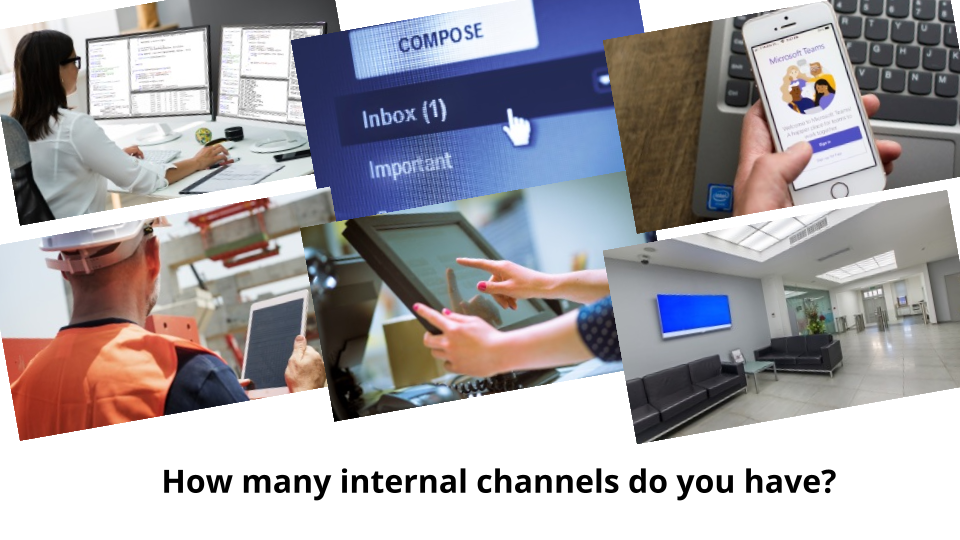
Today’s employees have a multitude of digital channels to help them do their work. One of the more exciting intranet trends of recent years is the idea of a digital workplace hub that consolidates all of these tools and channels. This sounds like a sensible idea until you really start to think about it. The fact is, unless employees can easily access their intranet from the platform where they spend most of their time, they’re not likely to bother stepping backwards to get there.
In response to this realization, Sam Marshall of ClearBox Consulting envisions a kind of aggregated digital workplace. One that offers flexible entry points with connections that are surfaced where they make the most sense to the employee. His idea is in line with other fresh intranet trends about how to organize communication, collaboration, and knowledge management. It’s called “the multi-channel intranet.”
 An aggregated digital workplace offers flexible entry points with connections that are surfaced where they make the most sense to employees.
An aggregated digital workplace offers flexible entry points with connections that are surfaced where they make the most sense to employees.
An engineer using a CAD system every day isn’t going to fire up an intranet first to click on the link in the ‘Tools’ menu (even if it is seductively called ‘Quick Links’).”
Sam Marshall, owner of ClearBox Consulting, The Myth of the Digital Workplace Hub
Mr. Robertson has proposed the concept of the multi-channel intranet. It manages information in what he calls a “platform-agnostic way,” sharing it in multiple channels and formats, thus ensuring it reaches all employees.
Robertson’s article, Create a Multi-Channel Intranet to Reach all Employees, calls for “multi-channel intranets that coordinate the delivery of content and communication across multiple channels and touch points.”
There are several advantages to taking a multi-channel approach to intranet strategy:
News and information can find employees where they are, not the other way around.
Comms can reach all touchpoints in all channels.
The option exists to “push” comms to specific channels.
There’s a single place to create and manage all news and messaging.
Employee experience platforms like Microsoft Viva offer great promise. But it’s unlikely that there will ever be a single place to consolidate the growing number of devices and channels used by today’s employees.
The better option is intranet software that can be used in parallel with other tools and platforms. For example, your intranet can be a publishing platform from which to push communication to the various channels in use by your company. In this way, it can sit alongside collaboration tools like Slack or Microsoft Teams and an employee app for reaching non-desk and frontline workers.







